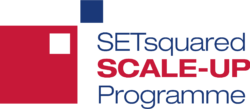SEARCH
Enter your search term below:
Close
Enter your search term below:

WORLD LEADING BUSINESS SUPPORT


The opportunity to take part in a sustainability workout, an online workshop which helps you scrutinise your existing business model to look at how you could evolve it to access new markets, adopt new financials model, find new value by streamlining internal processes and as a business become more sustainable.
This is open to SETsquared Scale-Up Members developing low carbon or sustainable products and services from all sectors including but not limited to technologies addressing renewable energy, waste to energy, alternative fuels, recycling, water treatment, air pollution, carbon capture and storage, alternative fuel vehicles and building technologies.
1. Understand sustainability and circular economy principles and where one company is positioned within its context.
2. Understand why innovation is important and how this can be achieved.
3. To provide tools and experience to re-examine participants existing business model, as captured in a Circular Economy Business Model Canvas.
4. To help identify alternative circular business model patterns and understand how to score the potential of each.
5. Identify one new model and develop an action plan to test and validate the new model.
6. To help identify and articulate potential needs for R&D that underpin participants’ new potential business models.
The opening session will set out the objectives for the 2 days of training and what we all hope to achieve through it. It also gives the opportunity for us all to get to know each other as a group as each company will present who they are, what is their value proposition, and why it matters.
What is Sustainability – UN Definition: “Sustainability meets the needs of the present without compromising the ability of future generations to meet their own needs”. This session maps out what a sustainable economy looks like. The benefits of a circular economy and what action can be adopted to reach circular economy as a business.
This session starts with a game of Sustainability Top Trumps to make the point that what is popularly assumed to be sustainable isn’t necessarily a good answer. Often, we need to pull back and look at the wider ecosystem to work out where the root problems really are and only then can we figure out the best ways to solve them. In addition, the world outside the company is changing with customer needs, regulatory regime, technology capabilities and competitive environment etc. evolving all the time. A successful company needs to understand these changes and work out how to exploit them to benefit the business and its goals.
This session explores innovation in the design of new products/services, and it defines criteria to follow when designing such products/services.
Explore how businesses need to innovate to evolve and shift their business models to continue to develop and grow. Understand the process of how to explore new business model options by looking at some shift patterns and exploring how this might be applied to your current business model.
Exploring Circular Economy business model patterns that change the way value is delivered to the customer, opening up new customer opportunities and improving the sustainability of the business. This is illustrated with case studies from companies from within SETsquared’s Alumni community and well-known successful businesses.
Exploring Circular Economy business model patterns which change the way the product is produced to reduce raw material use saving cost and opening up potential new product offers. This is illustrated with case studies from companies from within SETsquared’s Alumni community and well-known successful businesses.
Quick recap of the subjects and key takeaways covered on
A chance to reflect on the lessons of yesterday and develop some new ideas for your business using the sustainable business model canvas.
In this session, we introduce questions to assess your circular economy journey and business model design as a basis for assessing the qualities and characteristics of the new and evolved business models you have designed through the last sessions.
With the new/evolved business model selected this session will look to identify what key assumptions pose the most significant risks to its success. This is the starting point for identifying what might be needed to address these risks.
Consider how to validate the assumptions on which the new business model is based. Opportunity to explore the prioritised risks for the new/evolved business model selected and to identify how to address and test each of the top 3 risks.
The aim of this session is to consider what actions need to be taken to explore the new potential business model, and who will own those actions. Develop these into a plan that can be discussed in the speed mentoring session.
The aim of the speed mentoring session is to provide the opportunity for each participant to gain focused one-to-one feedback from programme facilitators and key members of the SETsquared Scale-Up programme to understanding opportunities for support from the SETsquared network.
Some further thoughts on the power and importance of innovation plus a chance to share collective views on what has been learnt and next steps in the journey.
Close